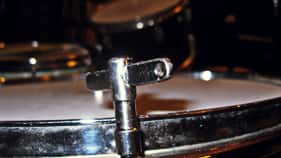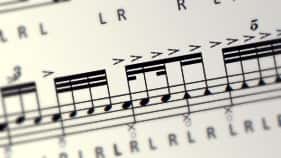
Drum Tuning
Drumhead Tuning – What’s the Right Way?
 There is not a right way. Any drum with two heads presents a quite a combination of tuning possibilities; the best sound being subject to personal preference. If it sounds good to the microphone, it’s right (if it sounds good to your ear but NOT the microphone – use a different microphone or place it differently). One drum tuning style may be great for one song, but it won’t be right for all songs. It’s best to experiment and find what YOU prefer as a drummer. After all, if the drumkit tuning feels and sounds good to you, then you will play with more ease and enjoyment.
There is not a right way. Any drum with two heads presents a quite a combination of tuning possibilities; the best sound being subject to personal preference. If it sounds good to the microphone, it’s right (if it sounds good to your ear but NOT the microphone – use a different microphone or place it differently). One drum tuning style may be great for one song, but it won’t be right for all songs. It’s best to experiment and find what YOU prefer as a drummer. After all, if the drumkit tuning feels and sounds good to you, then you will play with more ease and enjoyment.
The Key to Drum Tuning
The key to tuning drums is understanding the relationship between the two heads of the drum. The relationship is the same regardless of the drum’s diameter or type (tom, kick, snare, etc). The batter head is the one that is struck (top head) and the resonant head is the one that vibrates as air in between the two heads is compressed and expanded (bottom head).
Three Different Tuning Relationships
If the batter and resonant heads are tuned to the same pitch, the two heads resonate at the same frequency and reinforce each other. The drum will have the greatest possible amount of sustain and resonance.
If the resonant head is tuned higher than the batter head, there will be a slight pitch bend evident in the sustain of the toms. Also, because the impact is reflected off the tighter resonant head at a faster frequency (because it is tuned higher), the two heads no longer reinforce each other as much and there is less sustain.
If the resonant head is tuned lower than the batter head, you still have less sustain and a pitch bend (as opposed to both heads being the same pitch), but the pitch bend is much more pronounced from the resonant head. Also, the tom sounds a little more “tubby.”
Which of the Three Tuning Relationships Should I Use?
All of them! Seriously, try them all. Find what you like best. Over time, I have found that I prefer toms with a tighter resonant head. This is a classic sound heard on countless albums. It cuts, has the warmth that the pitch bend adds, and retains a “fast” quality. However, I have also found that equal tensioning on both heads provides good results when using bigger toms with a length equal to or greater than the diameter (ex. 10×10″, 11×13″, 16×16″, etc.).
How High or Low Should I Tune My Toms?
It’s both a matter of personal preference and musical genre. For instance, be-bop favors very high tuned toms. Rock usually favors very low tuned toms. Some players, John Bonham for instance, tuned really big deep toms higher than you would expect. The big toms produced the deep fundamental pitch and the higher tuned heads provided bounce and playability. Some players believe in tuning their toms to musical intervals (like thirds) or even tuning to the key of the song. I’ve done that on occasion on sessions that involve a lot of tom work, but normally pop music doesn’t require much in the way of tuning to particular intervals. Find a balance for yourself. Do you play a lot of fills on your toms? You’ll want a snappy response that comes from having a relatively taught batter head. Only use your toms for big simple monster fills? Tune them really low for a lot of initial attack and impact.
What Kind of Heads Should I Use?
What style of music do you play? How hard do you hit? How often can you afford to replace drumheads? The harder you hit and the less often you replace your heads, you’ll want heavier weight heads that can last long and put up with some abuse. If you play sessions or lighter styles of music, single ply heads will allow your drums to speak naturally and sustain longer. Coated heads are usually warmer compared to clear heads, which often have more attack or “bark” to them. Two-ply heads are good for killing excessive overtones (and sustain) and can mask some imperfections in shell construction found with cheaper drums. I personally use Evans drumheads most often in the following configuration for most pop and rock sessions:
Kick Batter: EMAD Coated (sometimes an Aquarian Super Kick 2 clear) – No beater pads
Kick Resonant: EQ-3 Reso Smooth White (with mic port)
Snare Batter: Power Center Reverse Dot coated
Snare Resonant: Hazy 300 Snare-Side
Tom Batter: G1 coated
Tom Resonant: G1 clear
A Word on Method
How do you tune your drums? There are tons of involved articles detailing this process, but here’s a brief overview. Mute the head on which you are not currently working. I usually tune my toms on a carpeted floor so I can hear only the head I am currently tensioning. Tune your head up to a higher pitch than you intend utilizing a cross-lug pattern of tuning (to avoid tightening the head too much on one side). Tap in front of each lug with your finger or a stick and make sure the lugs are tuned to the same pitch. Once all the lugs are tuned evenly, put some pressure on the head with the palm of your hand (DON’T do this with snare-side resonant heads). This is called seating the head. Once the head is seated, tune the head down to the desired pitch.
Additional Tom Tuning Tips
- For an extra little pitch bend on toms, and to cut help out sympathetic snare buzz a bit, slightly detune the batter head lugs farthest from you (maybe an 1/8 to 1/4 turn).
- On vintage drums, it is not uncommon for the metal hoops to be slightly out of round. This can make tuning a head frustrating. If the hoop is significantly out of round, purchase a new hoop.
- If you hear a lot of weird overtones and harmonics from the toms, resist the urge to muffle or tape them out. Instead, tune the drum until the overtones are at the absolute minimum. Tuning the resonant head higher or lower tan the batter should reduce overtones. Muffling should be a last resort (my opinion).
- If you have the money, you probably should replace your resonant heads when you replace your batter heads. At least change the resonant heads every other time. They wear out from the vibrations despite never being struck.
For more drum tuning information, check out my other entries on kick and snare tuning specifically.



3 Comments
Jonathan Kelly
Hi Chris,
i use a 68 Ludwig 3 ply set 12, 13, 14, 16,18 and I had Eddy Ryan build me a 26 inch kick before he died. The question is if your playing in a pub or average size room without microphones which tuning in your opinion gives the most projection, as a general rule i dont tune very low but medium low batter and the Bonham method higher resonant head in my opinion sounds great but I feel it sends the tone of the toms up to the mikes instead of out.front, lately i just drop the bottom head a semitone thinking that it slows the air from going back up to the batter side, two different head speeds may allow for more punch if not a little flatter sounding. Any ideas Chris?
cbdrums-admin
Hey Jonathan! I have to admit I don’t play out a lot in environments where the drums aren’t mic’d and so I haven’t thought about tuning for projection lately. Any time I have been in a situation where the drums aren’t mic’d, it’s usually a “please do not play loudly” situation like a jazz combo or something. You probably are right that higher tunings will project more, and the Bonham thing with larger toms tuned tuned higher (usually batter and resonant matched in tuning) should yield more projection. That’s only because, again, I’m not a trained acoustician, the equal tuning method usually has the most sustain and shell resonance. I really couldn’t speak for different batter and resonant tunings and how they affect projection.
All that said, were I you, I think I would start with whatever tuning sounded nice and inspiring to me. If you like how the kit sounds, you will enjoy every moment of the gig and, in my experience, so will the audience — regardless if everything projects or not.
chris
out of the three examples you have, I thought the last one sounded the best.
I tune my toms with rest head slightly looser than the batter head. on the snare tuning it depends on the snare. I most cases I tune the rest a bit looser or I tune them with even tension.